Bryan L. Programmable controllers. Theory and implementation
Подождите немного. Документ загружается.


959
CHAPTER
20
PLC Start-Up
and Maintenance
SECTION
6
Installation
and Start-Up
Industrial Text & Video Company 1-800-752-8398
www.industrialtext.com
SUMMARY OF TROUBLESHOOTING METHODS
In conclusion, the best method for diagnosing input/output malfunctions is to
isolate the problem to the module, the field device, or the wiring. If both
power and logic indicators are available, then module failures become readily
apparent. The first step in solving the problem is to take a voltage measure-
ment to determine if the proper voltage level is present at the input or output
terminal. If the voltage is adequate at the terminal and the module is not
responding, then the module should be replaced. If the replacement module
has no effect, then field wiring may be the problem. A proper voltage level at
the output terminal while the output device is OFF also indicates an error in
the field wiring. If an output rung is activated but the LED indicator is OFF,
then the module is faulty. If a malfunction cannot be traced to the I/O module,
then the module connectors should be inspected for poor contact or misalign-
ment. Finally, check for broken wires under connector terminals and cold
solder joints on module terminals.
control program checkout
dynamic system checkout
ground loop
master control relay (MCR)
panel enclosure
safety control relay (SCR)
static input wiring check
static output wiring check
system layout
wire bundling
KEY
TERMS
Industrial Text & Video Company 1-800-752-8398
www.industrialtext.com
This page intentionally left blank.

SYSTEM SELECTION
GUIDELINES
CHAPTER
TWENTY-ONE
This is not the end. It is not even the beginning
of the end. But it is, perhaps, the end of the
beginning,
—Winston Churchill
Industrial Text & Video Company 1-800-752-8398
www.industrialtext.com

962
SECTION
6
Installation
and Start-Up
Industrial Text & Video Company 1-800-752-8398
www.industrialtext.com
CHAPTER
21
System Selection
Guidelines
In this chapter, we will explain the procedures for selecting the proper
programmable controller for an application. We will explain how to deter-
mine application requirements, as well as how to evaluate PLC capabilities.
We will also provide several guidelines for defining and configuring the
control system, along with other factors that will affect the final selection.
After finishing this chapter, you will be able to select the PLC system that is
right for your application.
21-1 INTRODUCTION TO PLC SYSTEM SELECTION
As you have seen in this book, programmable controllers are available in all
shapes and sizes, covering a wide spectrum of capabilities. On the low end
are “relay replacers,” with minimum I/O and memory capability. At the
high end are large supervisory controllers, which play an important role in
hierarchical systems by performing a variety of control and data acquisition
functions. In between these two extremes are multifunctional controllers with
both communication capabilities, which allow integration with various
peripherals, and expansion capabilities, which allow the product to grow as
the application requirements change.
Deciding on the right controller for a given application has become increas-
ingly more difficult. With the explosion of new products, including general-
and special-purpose programmable controllers, system selection now places
an even greater demand on the designer to take a system approach to selecting
the best product for each task. Programmable controller selection affects
many factors, so the designer must determine which characteristics are
desirable in the control system and which controller best fits the present and
future needs of the application.
21-2 PLC SIZES AND SCOPES OF APPLICATIONS
Prior to evaluating the system requirements, the designer should understand
the different ranges of programmable controller products and the typical
features found within each range. This understanding will enable the designer
to quickly identify the type of product that comes closest to matching the
application’s requirements.
Figure 21-1, previously presented in Chapter 1, illustrates PLC product
ranges divided into five major areas with overlapping boundaries. The basis
for this product segmentation is the number of possible inputs and outputs
the system can accommodate (I/O count), the amount of memory available for
the application program, and the system’s general hardware and software
structure. As the I/O count increases, the complexity and cost of the system
CHAPTER
HIGHLIGHTS
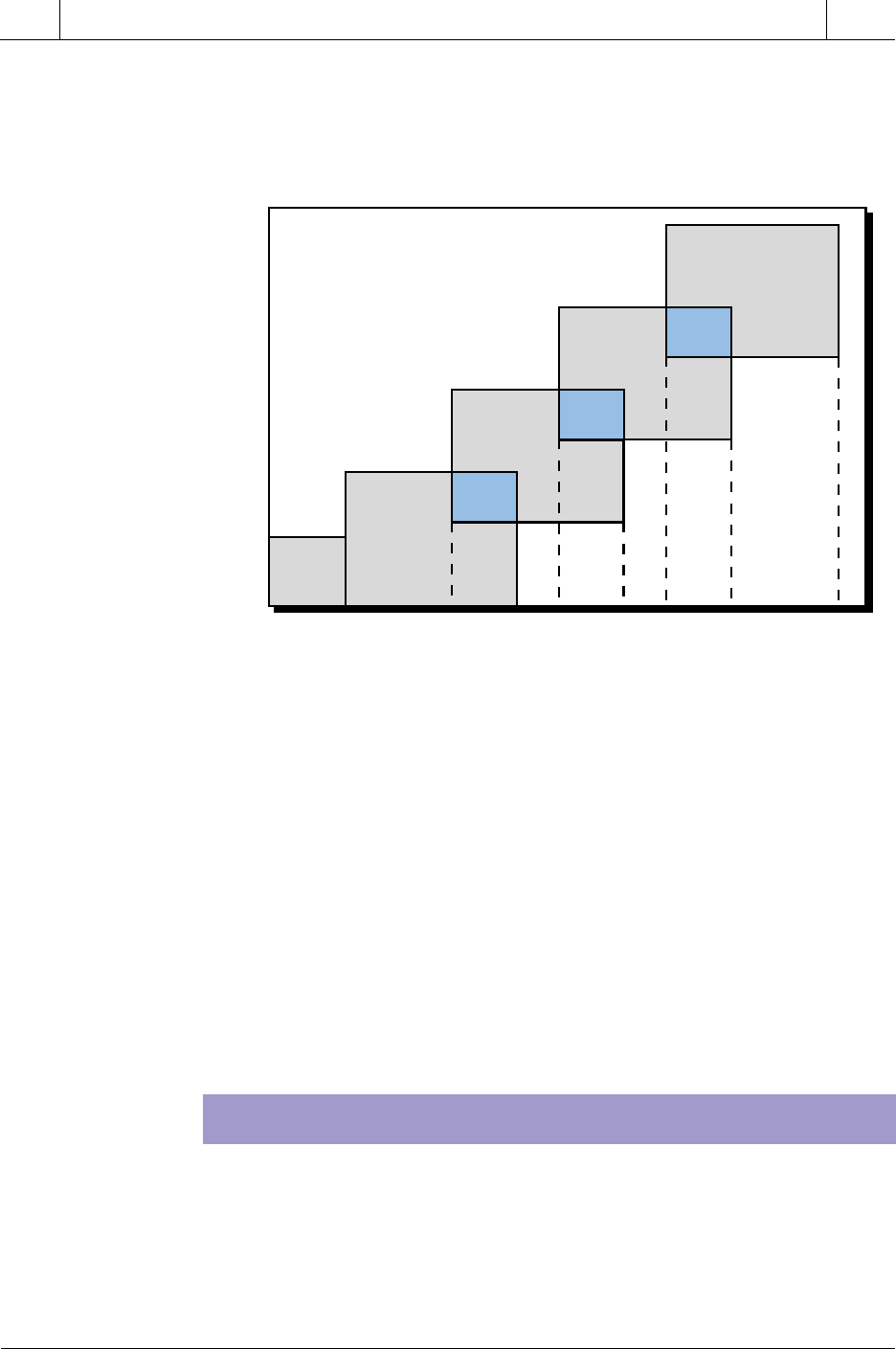
963
CHAPTER
21
System Selection
Guidelines
SECTION
6
Installation
and Start-Up
Industrial Text & Video Company 1-800-752-8398
www.industrialtext.com
Complexity and Cost
I/O Count
32 64 128 512 1024 2048 4096 8192
1
2
3
4
5
C
B
A
Figure 21-1. PLC product ranges.
also increase. Similarly, as the system complexity increases, the memory
capacity, variety of I/O modules, and capabilities of the instruction set
increase as well.
The shaded areas in Figure 21-1, labeled A, B, and C, reflect the possibility
of controllers with enhanced (not standard) features for a particular range.
These enhancements place the product in a gray area that overlaps the next
higher range. For example, because of its I/O count, a small PLC would fall
into area 2, but it could have analog control functions that are standard in
medium-sized controllers. Thus, this type of product would belong in area A.
Products that fall into these overlapping areas allow the user to select the
product that best matches the application’s requirements, without having to
select the larger product, unless it is necessary. The following discussion
presents information about the five PLC categories, as well as the overlap-
ping categories.
SEGMENT 1: MICRO PLCS
Micro PLCs are used in applications that require the control of a few discrete
I/O devices, such as small conveyor controls. Some micro PLCs can perform
limited analog I/O monitoring functions (e.g., monitoring a temperature set
point or activating an output). Figure 21-2 shows a typical microcontroller,
while Table 21-1 lists the standard features of micro PLCs.
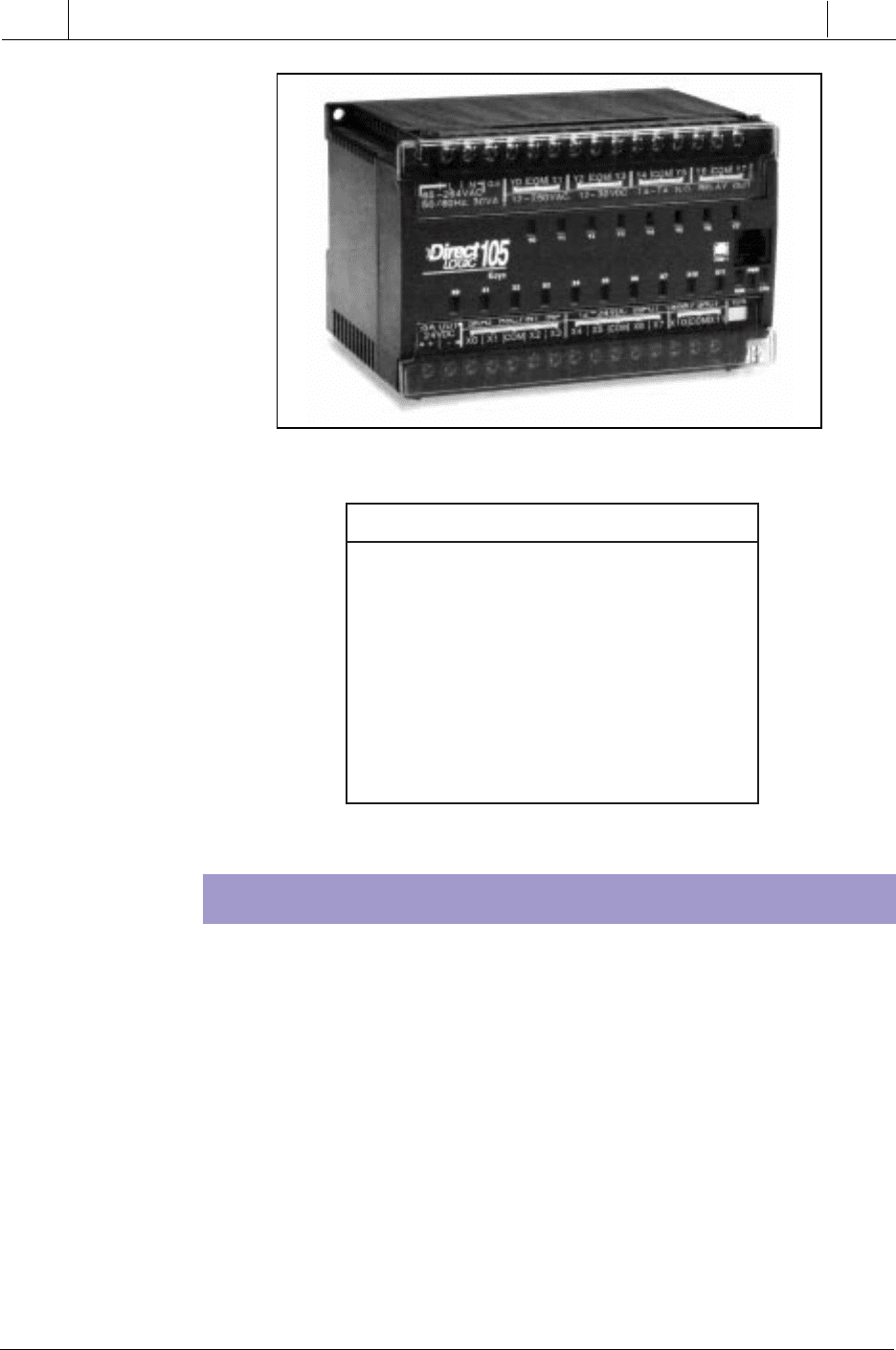
964
SECTION
6
Installation
and Start-Up
Industrial Text & Video Company 1-800-752-8398
www.industrialtext.com
CHAPTER
21
System Selection
Guidelines
Figure 21-2. PLC Direct’s micro PLC DL105.
Table 21-1. Standard features of micro PLCs.
SEGMENT 2: SMALL PLCS
Small controllers are mostly used in applications that require ON/OFF
control for logic sequencing and timing functions. These PLCs, along with
microcontrollers, are widely used for the individual control of small ma-
chines. Often, these products are single-board controllers. Table 21-2 lists
the standard features of small PLCs.
Area A. Area A includes controllers that are capable of having up to 64 or 128
I/O, along with products that have features normally found in medium-sized
controllers. The enhanced capabilities of these small controllers allow them
to be used effectively in applications that need only a small number of I/O, yet
require analog control, basic math, I/O bus network interfaces, LANs, remote
I/O, and/or limited data-handling capabilities (see Figure 21-3). A typical
application of an area A controller is a transfer line in which several small
machines, under individual control, must be interlocked through a LAN.
sCLPorciM
O/I23otpU•
rossecorptib-61•
recalperyaleR•
K1otpuyromeM•
O/IlatigiD•
tinutcapmocanisO/Ini-tliuB•
syalerlortnocretsaM•
sretnuocdnasremiT•
remmargorpdlehdnahhtiwdemmargorP•
Courtesy of PLC Direct, Cumming, GA
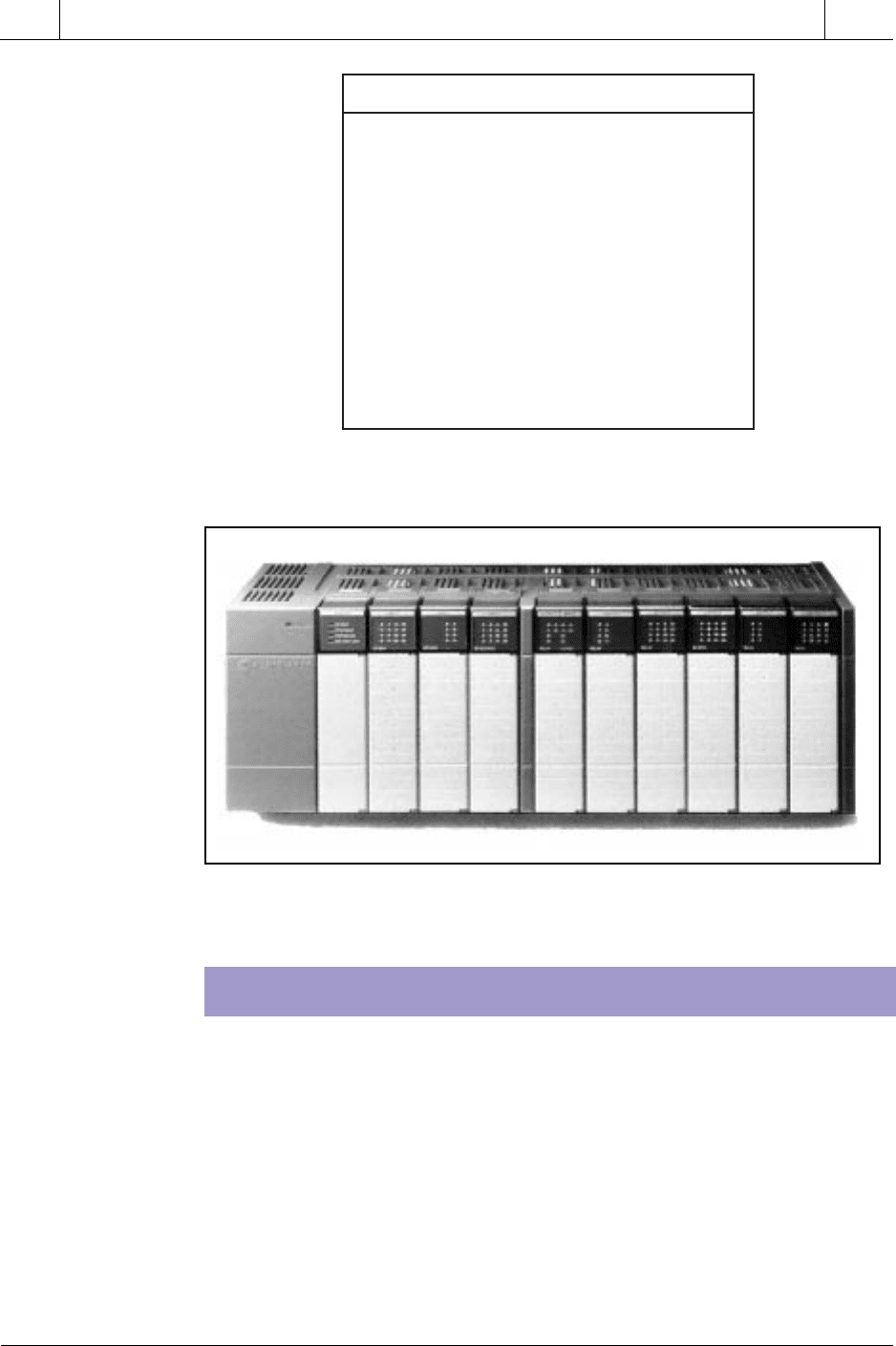
965
CHAPTER
21
System Selection
Guidelines
SECTION
6
Installation
and Start-Up
Industrial Text & Video Company 1-800-752-8398
www.industrialtext.com
Table 21-2. Standard features of small PLCs.
Figure 21-3. Area A (SLC500) controller capable of handling up to 72 discrete and 4
analog I/O.
SEGMENT 3: MEDIUM PLCS
Medium PLCs (see Figure 21-4) are used in applications that require more
than 128 I/O, as well as analog control, data manipulation, and arithmetic
capabilities. In general, the controllers in segment 3 have more flexible
hardware and software features than the controllers previously mentioned.
Table 21-3 lists these features.
Area B. Area B contains medium PLCs that have more memory, table-
handling, PID, and subroutine capabilities than typical medium-sized PLCs,
as well as more arithmetic and data-handling instructions. Figure 21-5 shows
a PLC that falls into this category.
sCLPllamS
O/I821otpU•
rossecorptib-61•
recalperyaleR•
K2otpuyromeM•
O/IlatigiD•
ylnoO/IlacoL•
ylnoegaugnalnaelooBroreddaL•
syalerlortnocretsaM•
sretsigertfihs/sretnuoc/sremiT•
srecneuqesrosremitmurD•
remmargorpdlehdnahhtiwdemmargorP•
Courtesy of Allen-Bradley, Highland Heights, OH
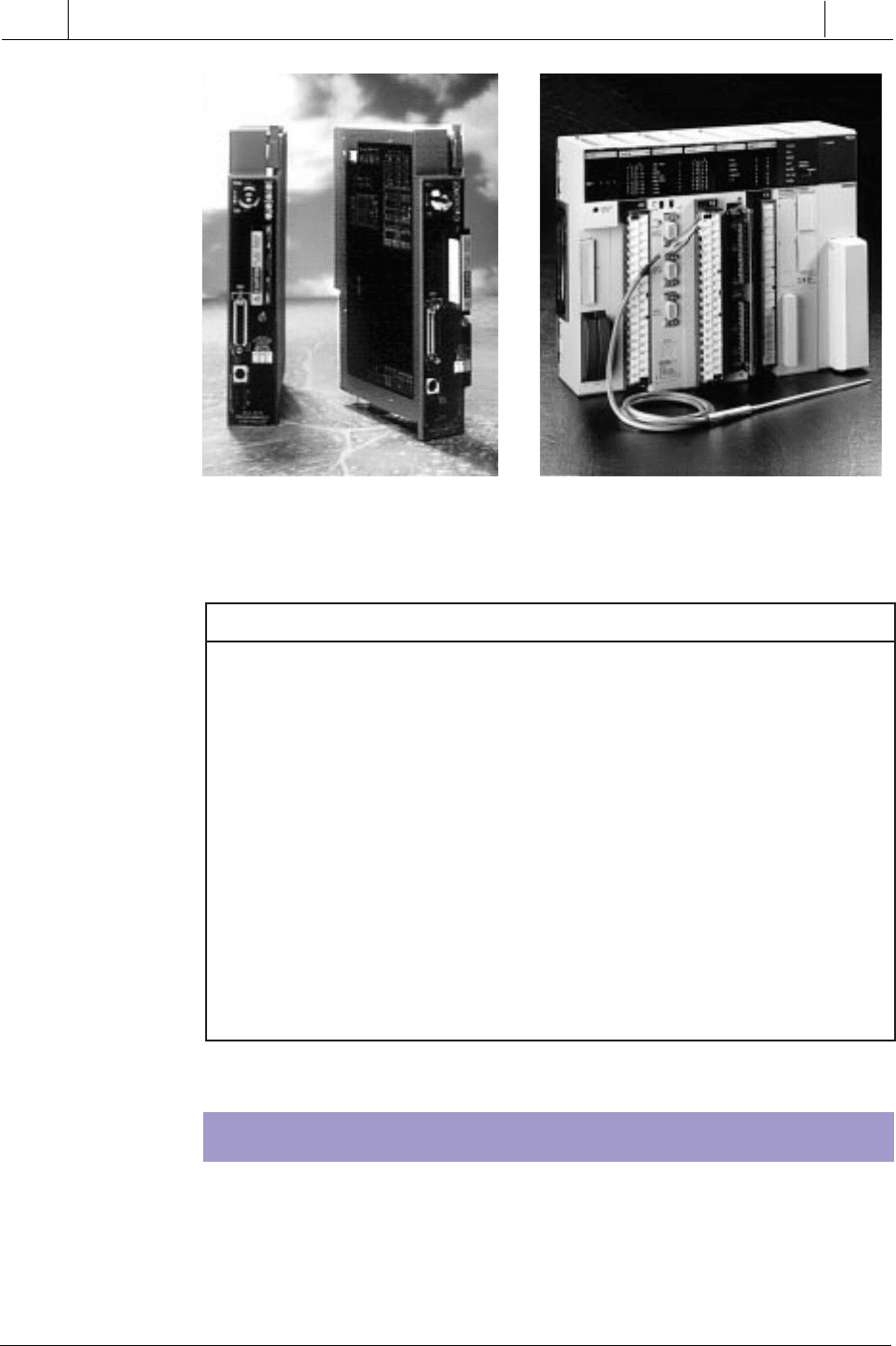
966
SECTION
6
Installation
and Start-Up
Industrial Text & Video Company 1-800-752-8398
www.industrialtext.com
CHAPTER
21
System Selection
Guidelines
Figure 21-4. Medium-sized PLC 5/11
(left) and PLC 5/20 (right) processors
with up to 512 I/O capacity.
Figure 21-5. Omron’s area B CV500 PLC
with a temperature control module (up to
1024 I/O).
Table 21-3. Standard features of medium PLCs.
SEGMENT 4: LARGE PLCS
Large controllers (see Figure 21-6) are used for more complicated control
tasks, which require extensive data manipulation, data acquisition, and
reporting. Further software enhancements allow these products to perform
complex numerical computations. Table 21-4 summarizes the standard
features of large PLCs.
sCLPmuideM
O/I4201otpU•seitilibapachtaM•
rossecorptib-23ro-61•noitiddA–
lortnocgolanadnarecalperyaleR•noitcartbuS–
sdrowK4otpuyromeM•noitacilpitluM–
K61otelbadnapxE•noisiviD–
O/IlatigiD•gnildnahataddetimiL•
O/IgolanA•erapmoC–
O/IetomerdnalacoL•noisrevnocataD–
egaugnalnaelooBroreddaL•elif/retsigerevoM–
egaugnallevel-hgih/kcolbnoitcnuF•snoitcnufxirtaM–
syalerlortnocretsaM•seludomO/InoitcnuflaicepS•
sretsigertfihs/sretnuoc/sremiT•tropnoitacinummoc232-SR•
srecneuqesdnasremitmurD•skrowtenaeralacoL•
pmuJ•skrowtensubO/ItroppuS•
Courtesy of Allen-Bradley, Highland Heights, OH
Courtesy of Omron Electronics, Schaumburg, IL
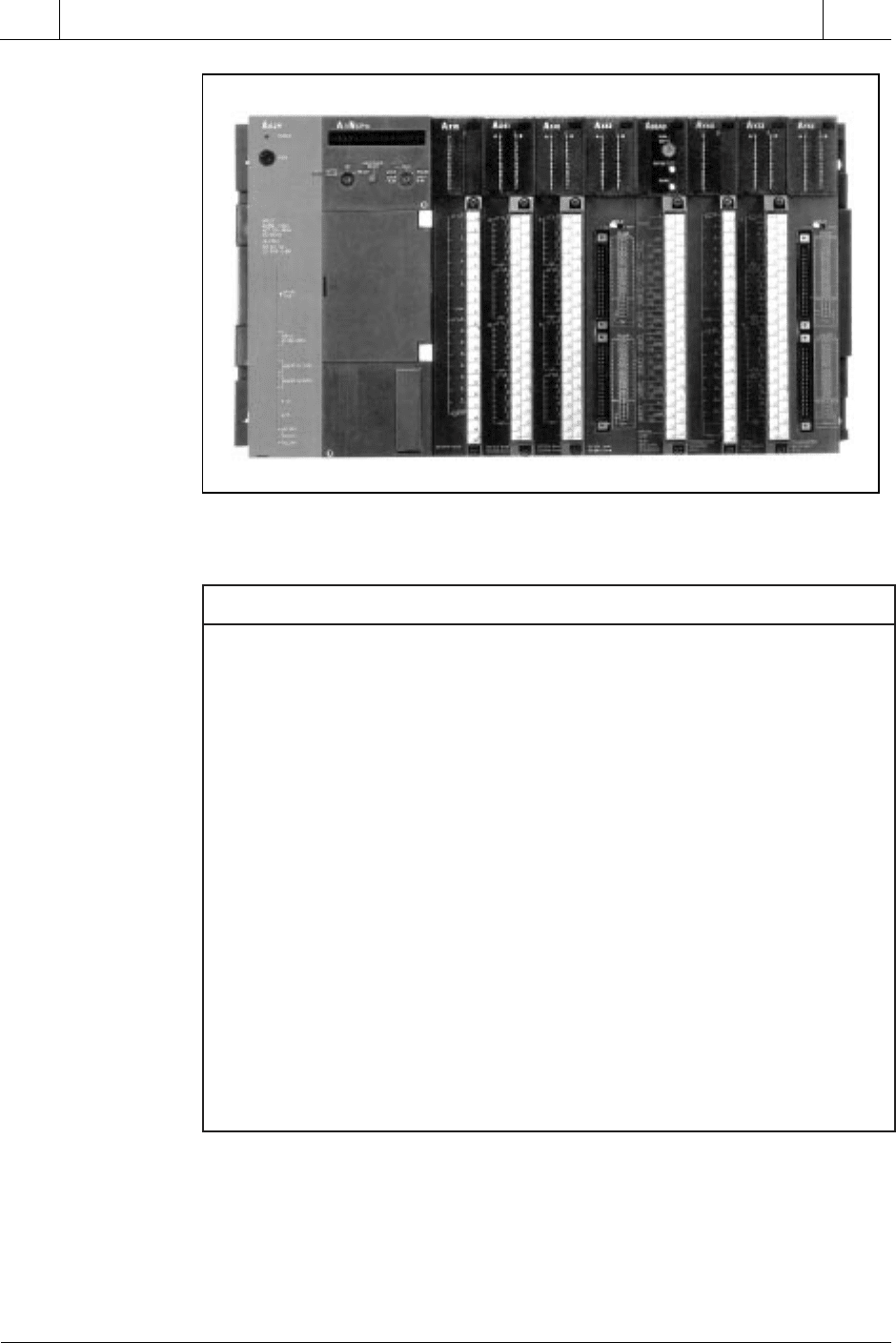
967
CHAPTER
21
System Selection
Guidelines
SECTION
6
Installation
and Start-Up
Industrial Text & Video Company 1-800-752-8398
www.industrialtext.com
Figure 21-6. Large Mitsubishi A3NCPU controller with 2048 I/O capacity.
Table 21-4. Standard features of large PLCs.
Area C. Area C includes the segment 4 PLCs that have a large amount of
application memory and I/O capacity. The PLCs in this area also have greater
math and data-handling capabilities than other large PLCs. Figure 21-7 shows
an example of this type of controller.
Courtesy of Mitsubishi Electronics, Mount Prospect, IL
sCLPegraL
O/I6904otpU•seitilibapachtaM•
rossecorptib-23ro-61•noitiddA–
lortnocgolanadnarecalperyaleR•noitcartbuS–
sdrowK21otpuyromeM•noitacilpitluM–
K821otelbadnapxE•noisiviD–
O/IlatigiD•toorerauqS–
O/IgolanA•noisicerpelbuoD–
O/IetomerdnalacoL•gnildnahataddednetxE•
egaugnalnaelooBroreddaL•erapmoC–
egaugnallevel-hgih/kcolbnoitcnuF•noisrevnocataD–
syalerlortnocretsaM•elif/retsigerevoM–
sretsigertfihs/sretnuoc/sremiT•snoitcnufxirtaM–
srecneuqesdnasremitmurD•refsnartkcolB–
pmuJ•selbatyraniB–
stpurretni,senituorbuS•selbatIICSA–
DIPerawtfosmetsysroseludomDIP•skrowtenaeralacoL•
stropnoitacinummoc232-SReromroenO• seludomO/InoitcnuflaicepS•
seludomnoitacinummocretupmoctsoH• skrowtensubO/ItroppuS•
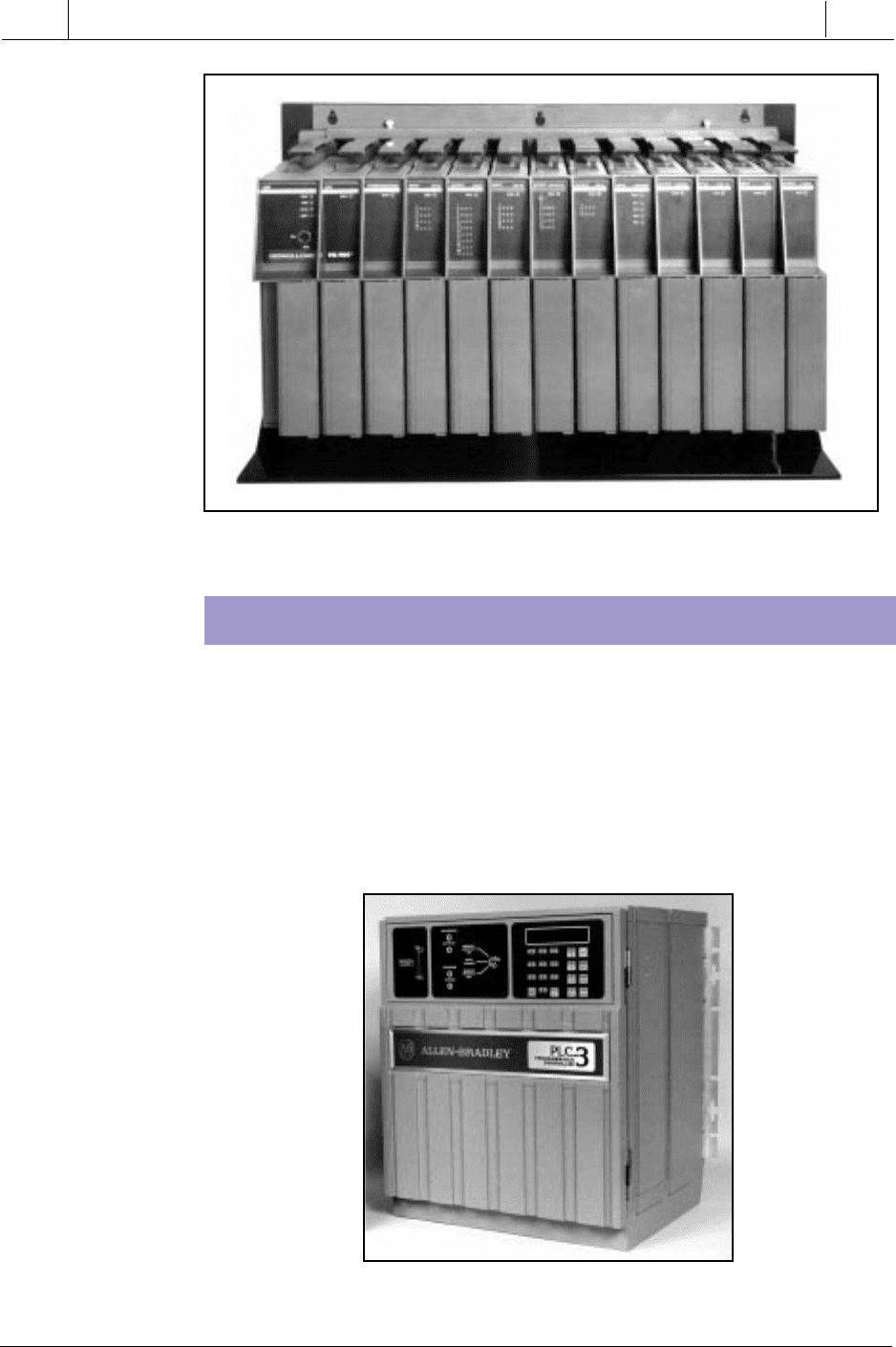
968
SECTION
6
Installation
and Start-Up
Industrial Text & Video Company 1-800-752-8398
www.industrialtext.com
CHAPTER
21
System Selection
Guidelines
Figure 21-7. Giddings & Lewis’s area C PIC900 with up to 3168 I/O and motion I/O, IEC
programming, and floating-point math capabilities.
SEGMENT 5: VERY LARGE PLCS
Very large PLCs (see Figure 21-8) are utilized in sophisticated control and
data acquisition applications that require large memory and I/O capacities.
Remote and special I/O interfaces are also standard requirements for this
type of controller. Typical applications for very large PLCs include steel
mills and refineries. These PLCs usually serve as supervisory controllers in
large, distributed control applications. Table 21-5 lists standard features
found in segment 5 PLCs.
Figure 21-8. Very large PLC-3 from Allen-Bradley with 8190 I/O capability.
Courtesy of Allen-Bradley, Highland Heights, OH
Courtesy of Giddings & Lewis, Fond du Lac, WI
